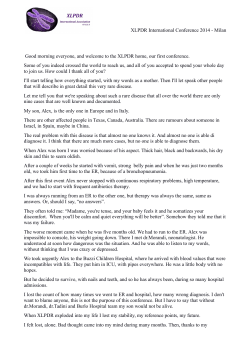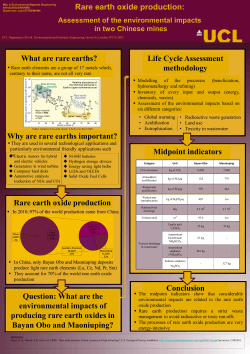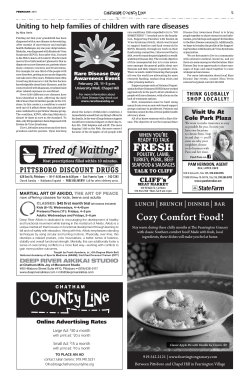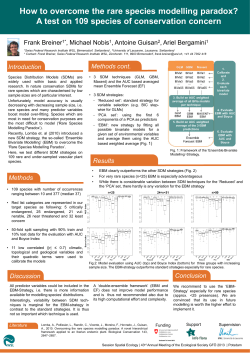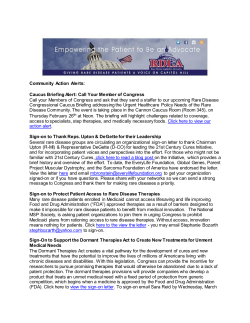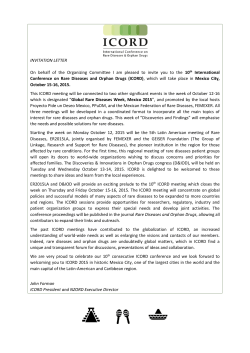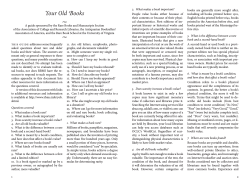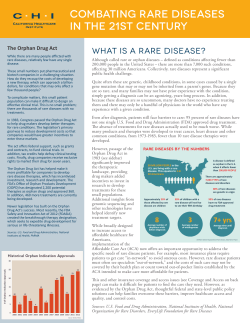
MICE TIMES - Basel Declaration
# 05 | February 2012 MICE TIMES Rare diseases – a widespread problem Rare diseases are not rare Diseases are regarded in Europe as «rare» when they affect less than one in 2000 people. Many rare diseases are very much rarer, occurring only once in 50'000 or 100'000 people, and in some instances there is only one known case in Switzerland. Nevertheless rare diseases are de facto quite common, because almost a quarter (about 7000) of all 30'000 or so known diseases are considered «rare». Estimates suggest that one in twenty patients suffers from a rare disease. Throughout Europe, then, about 20 million people are affected, and in Switzerland alone 400'000. That corresponds to almost the entire population of the City of Zurich. Simply on the basis of their relative frequency, «rare» diseases are considered as a single group, which is therefore very heterogeneous. About 80% inherited diseases and many other diseases of genetic origin must be classed as «rare». Besides a few well-understood and treatable conditions (e.g. thalassemia, phenylketonuria, Fabry disease, Gaucher’s disease etc.) there are also many diseases that are incurable at the moment. medicines are available for rare diseases, many more patients are found than were expected. Why is this? Doctors are often cautious with diagnosis, or simply do not recognize the disease , when the occurrence is very rare. But as soon as a cure is possible, the disease attracts more attention and tends to be diagnosed more often. Thus, the focus on rare diseases thus benefits everyone: biomedical scientists, patients and their doctors and also the pharmaceutical industry,» says Susan Gasser, Professor and Director of the Basel Friedrich Miescher Institute (FMI) and member of the Board of Trustees of the Gebert Rüf Foundation, which has supported research in rare diseases for many years. Ever better diagnosis For a long time, rare diseases were the «orphans» of human medicine, and indeed they are often called «orphan diseases». The interest of the pharmaceutical industry and of many physicians was limited for a long time. There was a dearth of the detailed knowledge needed for adequate and successful treatment and also a lack of the necessary medicines. «There are three important reasons for addressing rare diseases. First, genetic causes and the char- Major advances The situation indeed is constantly changing today for the benefit of those affected. In the past few years, numerous research groups – especially in Switzerland – have made progress in the diagnosis and search for treatment options, the interest of industry has increased and the leaders responsible for health policy are pushing for a national strategy. In mid-July 2011 there were 105 medicines in Switzerland approved for 145 rare disease indications, and since the beginning of 2010 Swissmedic has approved 45 applications for new treatments. Some of these medicines can be used for several rare diseases, for example growth hormones in Prader-Willi patients and in patients with Turner syndrome, because short stature is a feature of both groups of patients. Researchers are establishing how more and acteristic features of disease are often very closely linked. Second, there are usually very strong patient organizations and support groups that are in search of treatment options and are encouraging research. Third, it is known from experience that as soon as more rare diseases arise. This is the basis for the development of a successful medicine. «It is hoped that we shall make a really big step forward in the field of rare diseases in the coming decades», explains Susan Gasser. Together with a guest researcher from the «There is no disease so rare that it does not deserve attention. Rare diseases are rare, but rare disease patients are numerous» www.orpha.net Protecting patients from their own immune system Patients with Muckle-Wells syndrome (MWS), a rare inherited autoimmune disease, suffer from symptoms such as extremely red eyes, eczema, fevers or chills, severe headaches and migraine, extreme exhaustion and muscle and joint pain. Siobhan Walsh from England has suffered from this disease from birth. Her mother died with many of the above symptoms without ever having been diagnosed with MWS, because although Thomas J. Muckle and Michael Wells described the disease in detail back in 1962, it was only in 2001 that researchers found that MWS is caused by the mutation of a gene. After this, the mechanism of action was quickly established: The inflammation of a wide variety of tissues in MWS is caused by overproduction of a protein by the immune system, interleukin-1 beta (or IL-1β for short). Everyone’s immune system produces IL-1β to fight disease. If too much of these antibodies are produced, however, the immune system «fights» its own body. Since 2009 patients like Siobhan Walsh have had a medicine at their disposal that intercepts excess IL-1β in the body. It is a completely human antibody against IL-1β and does not contain genetic sequences from other species. This molecule is manufactured in cell cultures from human cells. Besides bacteria and yeast cultures, the development of the product also required the use of transgenic mice, in whose genetic material the genetic code for anti-IL-1β was first incorporated. In later steps, the components from mouse genes were then gradually replaced by human genes. For this purpose and in order to study the mechanism of action further genetically modified animals, mainly mice, were used. Before its first use in hu- mans the product was then tested, as with any other medicine, for its safety and efficacy in healthy rodents and mammals. Without such animal experiments no medicines will be approved by the authorities for clinical studies or for marketing. Siobhan Walsh was one of the first patients to be treated in clinical studies with the product. «All the symptoms I had suffered from for years disappeared within a few hours, and after just 48 hours I knew that it really works! Because I had never had two full days of good health in my entire life before.» As a result of the disease, Siobhan could only walk with the aid of crutches from the age of 15 years. Today she no longer needs them. She works full-time as a taxi driver, can live independently now and, as she reports, can now lead a normal social life. In the meantime the medicine is approved in Europe and the USA for the treatment of MWS and clinical studies are under way for its use in other severe rare diseases. Hebrew University in Jerusalem, her study group recently elucidated the molecular mechanism of the inherited Emery-Dreifuss muscular dystrophy in all its detail with the aid of experiments in the nematode Caenorhabditis elegans. A modified structural protein of the inner membrane of the cell nucleus, lamin A, plays a crucial role not only in this rare muscular dystrophy, but also in the rare inherited disease known as progeria infantilis (also Hutchinson-Gilford syndrome). Here a point mutation of lamin A leads to a deformation of the cell nucleus. Children affected are born without any abnormalities and develop the first symptoms at the age of six to twelve months: They age five to ten times more quickly than healthy people. The acute and future challenges for the health of humans, pets and farm animals make huge demands on scientists. But they are bearing fruit in- animal experiments for the health of humans and animals,» says Professor Burkhard Ludewig, Director of the Medical Research Center, Institute of Immunobiology, Cantonal Hospital St. Gallen. Fig. 1: zebrafish creasingly often – also for rare diseases. Matthias Baumgartner, professor and specialist in rare metabolic diseases at the pediatric hospital in Zurich, gives an example: «In diseases of the red blood cells such as sickle cell anemia or thalassemia, the technical feasibility of studying hemoglobin and its production revealed that there are many different forms of thalassemia, and for the first time it became possible to research the underlying defects. Today, it is mainly the glimpse into genetic material that is proving an enormous help to doctors identifying many rare diseases with precise and relatively quickly.» Animals help to gain deeper insights Researchers first cast this glimpse into the genetic material of animals in order to identify the basic principles and understand the mechanisms. Generally animal experiments make a major contribution in helping to carry over pioneering discoveries from basic biological research into applied research. They have a key function for the discovery of life processes, the elucidation of diseases and the development of new medical procedures for humans and animals: In 75 of 98 research studies that led to the award of a Nobel Prize for Medicine and Physiology, animal experiments were directly involved. «The high quality of medical care at the present time would not have been achieved without research in animal experiments. It is important to inform society about the major importance of research using Fig. 2: nematodes The use of experiments in animal species such as nematodes or zebrafish tends to be tolerated more than experiments in mammals, especially when they involve genetic modification. «The most important test models for fundamental studies are – in most cases genetically modified – rodents. However, to test promising results in clinical use, animal models are necessary that are closer to humans in terms of anatomy and physiology», says Professor Eckhard Wolf, Chair in Molecular Animal Breeding and Biotechnology of Ludwig Maximilian University «The high quality of medical care at the present time would not have been achieved without research in animal experiments.» Prof. Dr. Burkhard Ludewig Munich. «For various reasons, the pig, for example, is especially suitable for many research fields in rare diseases. Advances in the elucidation of its genetic material and in high-performance and cost-effective transgenic technologies will further increase its importance.» The study group headed by Eckhard Wolf is using genetically modified piglets in its research for new solutions in Tay-Sachs disease amongst others. This congenital metabolic disorder leads to severe deterioration in mental abilities along with blindness. Affected infants usually die by the age of three years, because to date it is only possible to treat the symptoms in this rare genetic disease. A few examples of other successes in rare diseases of the last few years: • Chronic myeloid leukemia: a rare form of blood cancer with a pronounced increase in white blood cells can be very successfully treated with medca- tion in many cases. • Phenylketonuria: about one in 10'000 newborn infants must keep their intake of the amino acid phenylalanine as low as possible; otherwise they run the risk of severe brain damage. A new medi cine helps those affected to relax their strict diet. • Gaucher type 1: anemia that can be treated rela tively well today, depending on the severity of the disease, with enzyme replacement therapy or with medication. It would be ideal if we could understand the complicated mechanisms of a body without stressful animal experiment. Unfortunately that is not yet possible today, although researchers have for a long time conducted countless experiments with cells and tissues and, in the age of system biology, are also increasing our knowledge by means of computer simulation. But the dilemma will remain for a long time to come: basic research without experiments in animals would mean abandoning any medical progress. Mausblick aims to explain why and therefore reports on medical success stories that were only possible thanks to animal experiments. IMPRESSUM Editors: Basel Declaration Society, www.basel-declaration.org Münchhaldenstrasse 10 Postfach 8034 Zürich info@forschung-leben.ch www.forschung-leben.ch www.recherche-vie.ch Autorin: Dr. Sabine Rosta Redaktion: Astrid Kugler «Forschung für Leben»
© Copyright 2025
